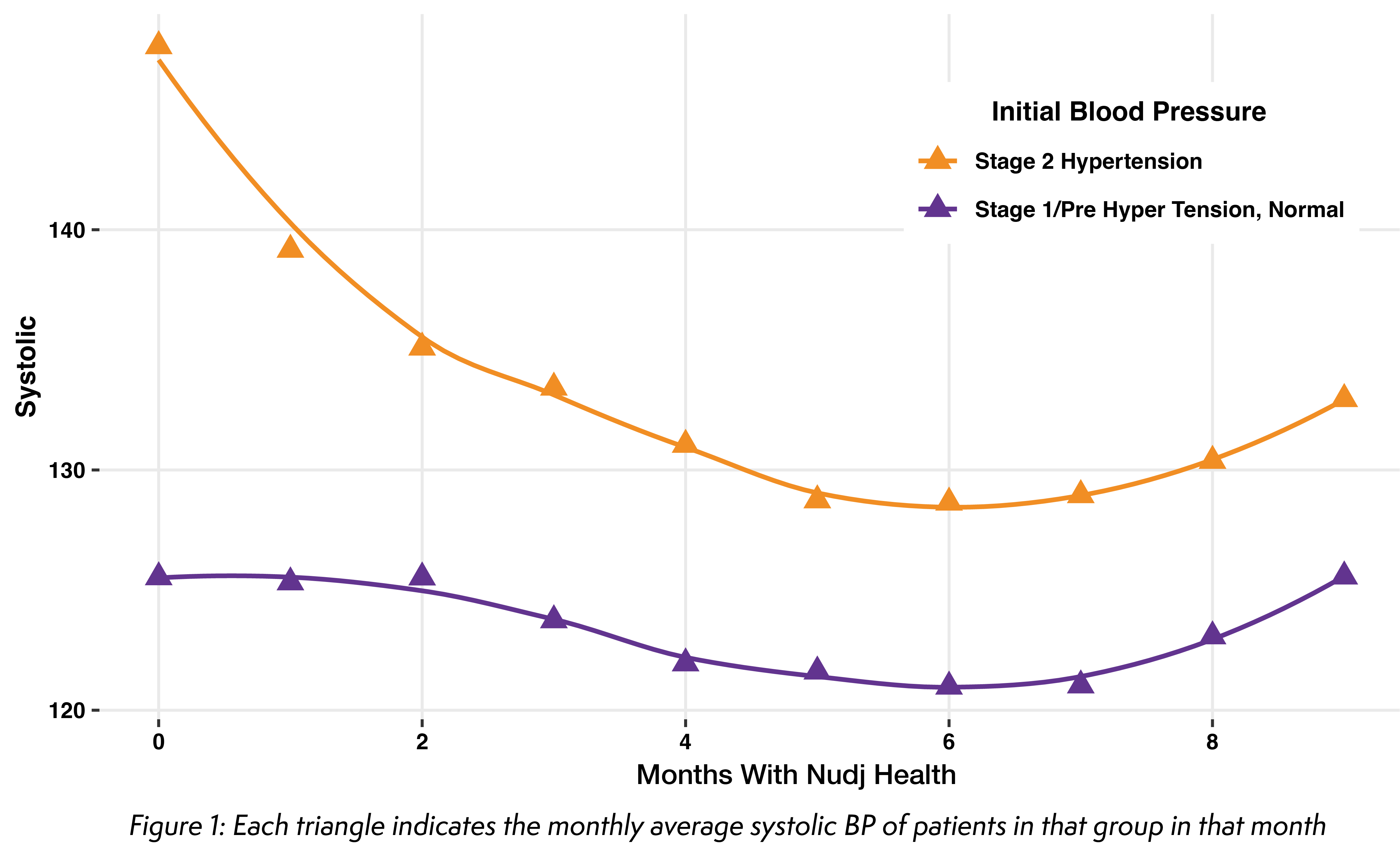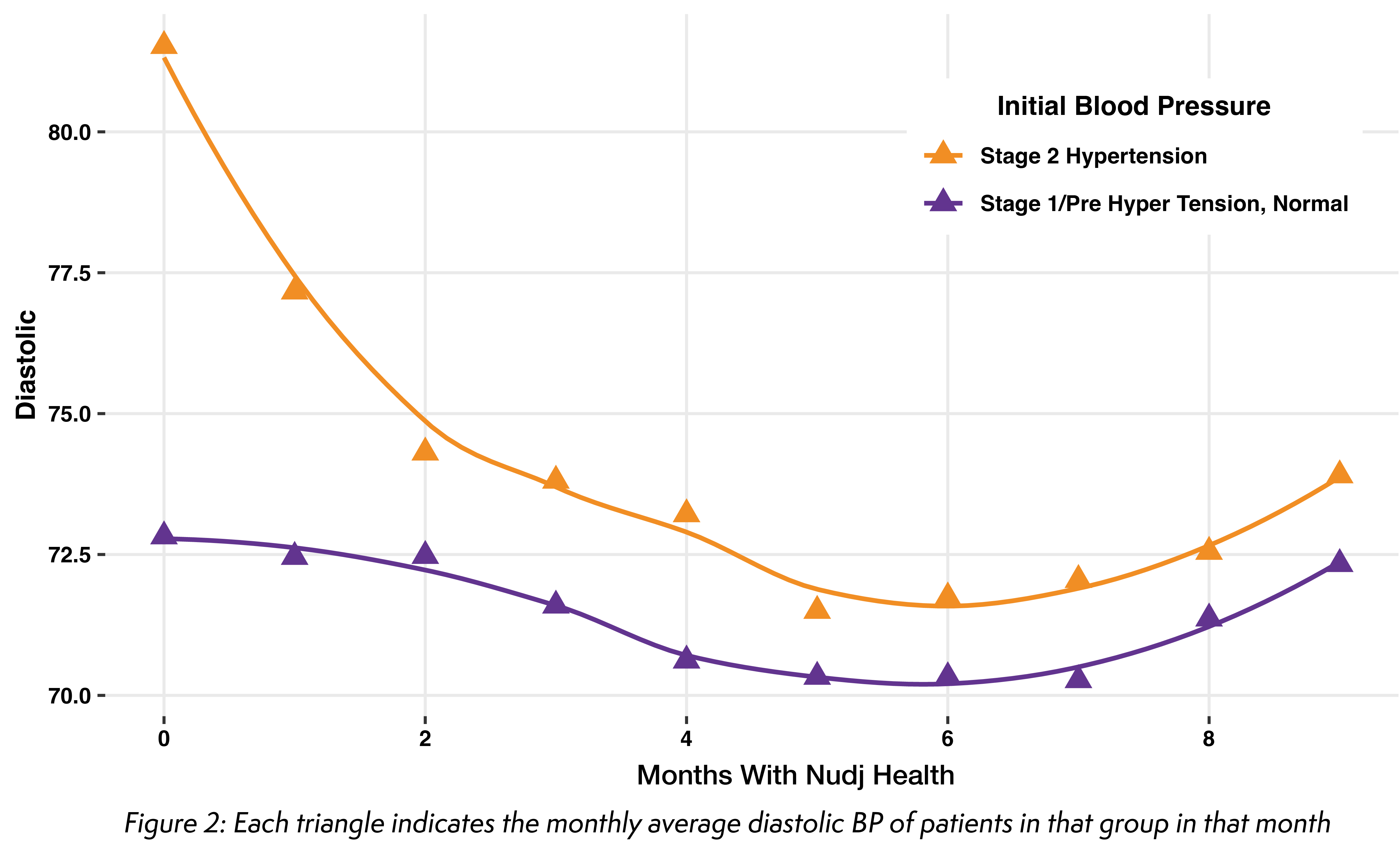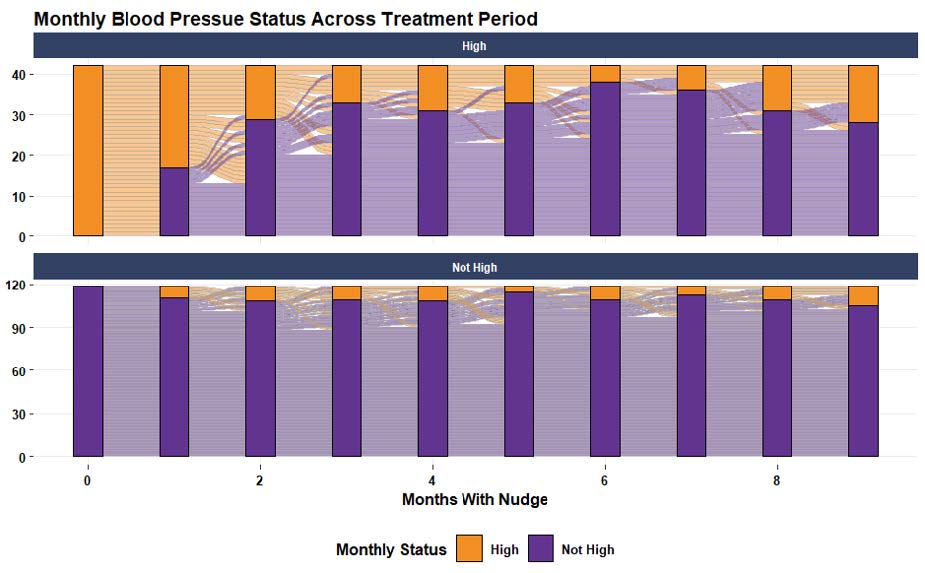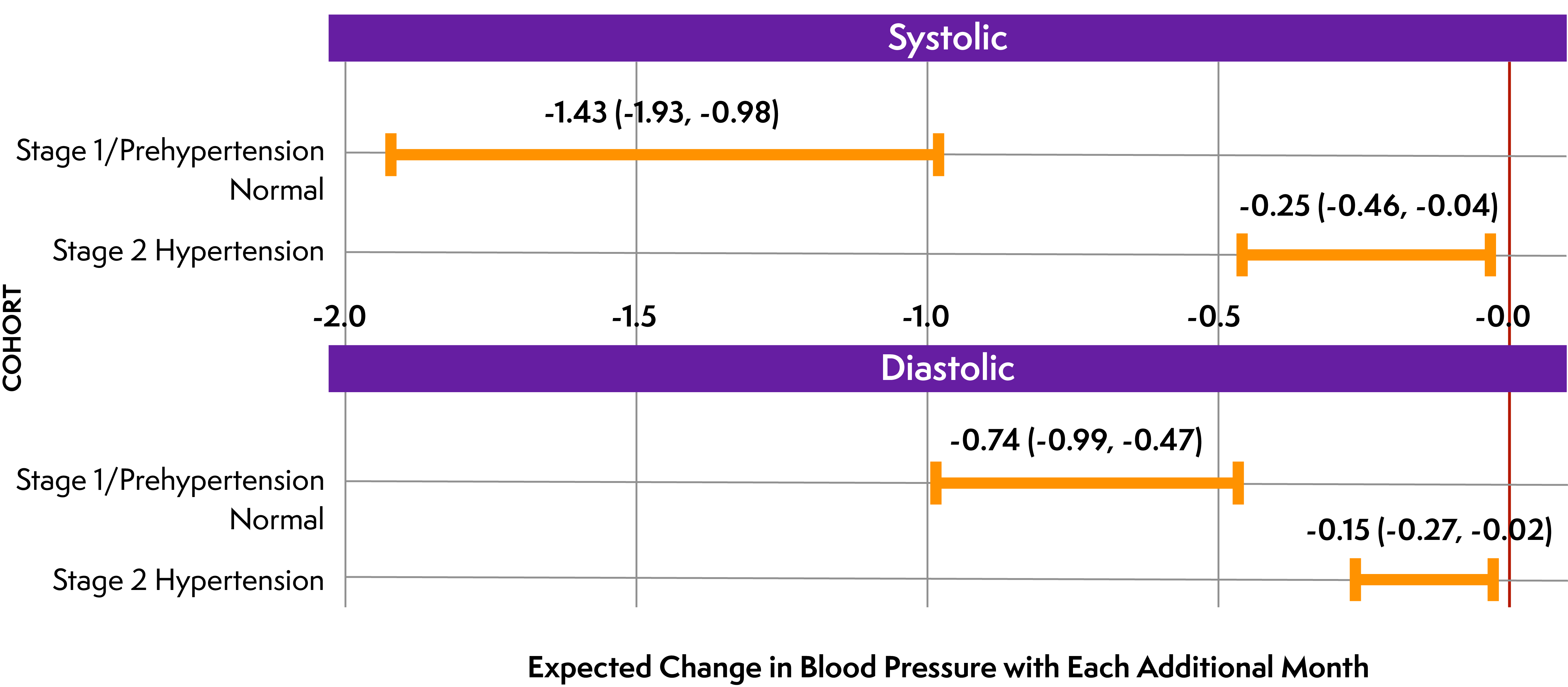Nudj Health announces clinical outcomes for cardiovascular risk reduction in a Medicare cohort predominantly based in Southern California.
Patients who participated in both a lifestyle treatment pathway and remote patient monitoring (RPM) were more likely to remain in treatment the full 9 months studied when compared to those receiving RPM services alone.
Seventy-four percent of patients with Stage 2 Hypertension (>140/90 mmHg) treated by Nudj Health achieved normal blood pressures by 4 months of treatment. Analysis of individual outcomes demonstrated that most patients with Stage 2 Hypertension moved into lower risk categories while relatively few patients experienced worsened blood pressures.
Additionally, statistical modeling to estimate the correlation between months of participation in Nudj programming and blood pressure response showed the expected change in BP with each additional month of treatment was -1.43 mmHg systolic (CI -1.93, -0.98), and -0.74 mmHg diastolic (CI -0.99, -0.47).
Findings also indicate that Stage 1 and prehypertensive patients also experienced decreases in blood pressures with each additional month of Nudj treatment.
Introduction
I’m pleased to report the clinical outcomes for Medicare patients treated in Nudj Health’s Collaborative Care Lifestyle Medicine program. Our treatment aims to reduce risk factors for, and chronic disease itself, via lifestyle change, improved psychological health, and improved disease management. In this report we describe the outcomes of our patients receiving evidence-based behavioral health treatment via the collaborative care method to decrease cardiovascular risk. Most patients, >90%, resided in several areas of Southern California. This data represents blood pressure measurements collected during routine care. Our treatment aims to reduce risk factors for, and chronic disease itself, via lifestyle change and improved psychological health. In this report we describe the outcomes of our patients receiving evidence-based behavioral health treatment via the collaborative care method to treat hypertension and associated chronic disease.
Cardiovascular Risk Reduction with Blood Pressure Monitoring
Our evidenced-based treatment for hypertension and other cardiovascular diseases includes a treatment-to-target approach. To this end, patients receive connected blood pressure devices that send measurements remotely to the partnering physician’s office. A total of 2,000 patients received blood pressure monitoring services over a period ranging from 0 to 9 months. Of those patients, 496 individuals had an initial average blood pressure of Stage 2 Hypertension or worse, (blood pressure >140/90 mmHg).
In this analysis we have chosen to divide the cohort into 2 groups; those with Stage 2 Hypertension in one and Stage 1 Hypertension patients, prehypertensive patients, and normal blood pressure patients in the other. However, we understand that patients with prehypertension and Stage 1 Hypertension would also benefit from blood pressure reduction. In other clinical updates we have separated out those groups in more detail and have shown decreases in blood pressures with Nudj treatment.
Patient Demographics
The demographics of the group that received blood pressure monitoring is represented in the table below. Length of treatment in this cohort ranged from 1 to 9 months. This data represents routine clinical outcomes that are collected in the regular course of patient treatment. As such, some patients who have been treated in the program for many months did not have measurements from every month of treatment. The group of patients that had a measurement in each month is labeled “Complete”. The group comprised of patients that have one or more measurements after their initial month are labeled “Incomplete.” Patients who participated in both a lifestyle treatment pathway and RPM were more likely to remain in treatment the full 9 months studied when compared to those receiving RPM services alone.
| Complete (n=160) | Incomplete (n=1, 840) | Overall (n=2,000) | ||
| Age | Mean (SD) | 76.7 (8.09) | 74.5 (10.4) | 74.6 (10.3) |
| Median (Min, Max) | 77.0 (40.0, 98.0) | 75.0 (23.0, 99.0) | 75.0 (23.0, 99.0) | |
| Gender | Female | 81 (50.6%) | 900 (48.9%) | 981 (49.1%) |
| Male | 79 (49.4%) | 940 (51.1%) | 1019 (51.0%) | |
| Initial BP | Stage 2 Hypertension | 42 (26.3%) | 454 (24.7%) | 496 (24.8%) |
| Stage 1 / Prehypertension, Normal BP | 118 (73.8%) | 1386 (75.3%) | 1504 (75.2%) | |
| Lifestyle | On 1+ Lifestyle Pathways | 70 (43.8%) | 633 (24.7%) | 703 (35.2%) |
| RPM Only | 90 (56.3%) | 1207 (65.6%) | 1297 (64.9%) | |
Population Blood Pressure Changes Over Time
Seventy-four percent of patients who initiated treatment with Nudj and had an initial blood pressure >140/90 mmHg were at or below normal levels by 4 months. Maximum blood pressure decrease occurred around six months, followed by a small increase in blood pressures. Patients whose initial blood pressures fell in the Stage 1 Hypertension or lower group also experienced a lesser magnitude of decrease in blood pressure, likely driven by Stage 1 Hypertension and prehypertensive patients rather than normotensive patients whose blood pressures are unlikely to decrease significantly. These outcomes are represented graphically in the figures below.


Individual Blood Pressure Changes Over Time
Another interesting way to visualize this data is to consider individual responses to treatment over time. Each patient whose initial BP measurement was >140/90 mmHg is represented by an orange line. When a line moves up into the purple section, this indicates the patient’s blood pressure has dropped below 140/90 mmHg. Patients whose initial blood pressure measurements were <140/90 mmHg are represented by purple lines. As this figure indicates, blood pressure changes are dynamic and some patients achieve improvements in BP that are then followed later by worsening blood pressures. Overall, most patients (~76%) with Stage 2 Hypertension at program initiation moved into lower risk categories while relatively few patients experienced worsened blood pressures. These outcomes are represented graphically in the figures below.

Effect of Length of Time in Nudj Treatment on Blood Pressure
Following individual patient outcomes over time allows us to estimate the correlation between months of participation in Nudj programming and blood pressure. We used linear mixed effect modeling and adjusted for the age of patients at program start in addition to time per month spent with the treatment team, to determine the associated monthly change in blood pressures. For those individuals whose initial BP was >140/90 mmHg, expected change in BP with each additional month of treatment was -1.43 mmHg systolic (CI -1.93, -0.98), and -0.74 mmHg diastolic (CI -0.99, -0.47). Even those individuals whose initial blood pressures were <140/90 mmHg were found to have an expected change in BP with each additional month of treatment of -0.25 mmHg systolic (CI -0.46, -0.04) and -0.15 mmHg diastolic (CI -0.27, -0.02). This information is summarized in the figure below.

This means that a typical patient who remains in the Nudj program for 5 months would experience a change in blood pressure of -7.15 mmHg systolic and -3.7 mmHg diastolic, or a change large enough tomove an individual from Stage 2 Hypertension to Stage 1 Hypertension. Additionally, a patient who participates in the Nudj program for 9 months would experience a change in blood pressure of -12.87 mmHg systolic and -6.66 mmHg diastolic, or a change large enough to move an individual from Stage 2 Hypertension to prehypertension. On a population level, the magnitude of change in BP seen after treatment with Nudj Health’s cardiovascular risk reduction program is highly significant: decreases of 5 mmHg systolic blood pressure decrease stroke mortality by 14%, coronary heart disease mortality by 9%, and all-cause mortality by 7%1.
Conclusion
Medicare patients treated in Nudj Health’s cardiovascular risk reduction program with initial BP measurements of Stage 2 Hypertension or greater experienced changes in blood pressure of -12.87 mmHg systolic and -6.66 mmHg diastolic over the course of 9 months, or a change large enough to move an individual from Stage 2 Hypertension to prehypertension. Additionally, reductions in blood pressure occurred rapidly during the 9 month treatment course: 74% of patients who initiated treatment with Nudj and had an initial blood pressure >140/90 mmHg were at or below normal levels by 4 months. Participation in a lifestyle pathway appears to improve adherence to BP monitoring, as a larger percent of patients with BP measurements over the course of the 9 months participated in a lifestyle + RPM treatment pathway rather than RPM treatment alone when compared to the overall group with at least one measurement during the treatment period.
We are planning future randomized clinical trials to compare patient outcomes after Nudj treatment for cardiovascular risk compared to patients treated with typical care. We continue to focus on delivering highly effective and efficient care for chronic diseases that can be significantly reduced by lifestyle
References
- Stamler R. Implications of the INTERSALT study. Hypertension. 1991;17(1 Suppl):I16-I20. doi:10.1161/01.hyp.17.1_suppl.i16